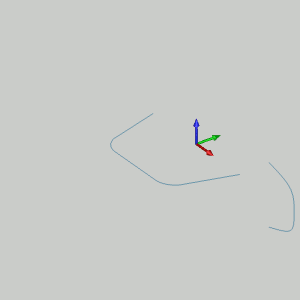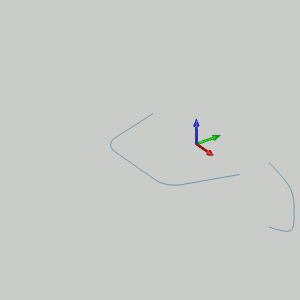 Swung Surface
Swung Surface
Introduction
This topic will explain the Swung Surface function, and the options found in it. This topic will also describe where to find the function, provide quick steps and an example on how to use it, and provide links to related topics.
The Swung Surface Function
The Swung Surface function is used to create surfaces using two wireframe chains: the path (trajectory curve) and the profile. The profile is swung along the path using the Z-axis of the Active UCS as the revolution axis for the function. The geometry selection requires that the path is selected in the XY plane, and the profile is selected in the XZ plane of the Active UCS. The path is selected before the profile with both using chain selection. Both the path and the profile can be open or closed chains.
|
Follow Trajectory Curve |
Follow Profile Curve |
|
|
|
Tip: There are three main points for successful swung surface creation:
1) The path must be selected on the XY plane of the Active UCS when creating the surface.
2) The profile must be selected on the XZ plane of the Active UCS when creating the surface.
3) The Z-axis of the Active UCS is the revolution axis, so its location in reference to the profile and path has an effect on the results.
Navigation
To open the Swung Surface function:
- In the Advanced Surfaces group, of the Create 3D tab, click
 Swung Surface.
Swung Surface.
The parameters display in the Data Entry Manager.
The Data Entry Parameters
-
 Preview - Select the check box to enable the CAD preview, which displays what the result will be before you create it. Once all geometry is selected, the preview is shown.
Preview - Select the check box to enable the CAD preview, which displays what the result will be before you create it. Once all geometry is selected, the preview is shown.  Preview - Clear the check box
to turn off the CAD preview.
Preview - Clear the check box
to turn off the CAD preview.
Trajectory Curve on XY plane
|
|
|
| This list box will show the entity currently selected for the function. | |
Profile Curve
|
|
|
| This list box will show the entity currently selected for the function. | |
Parameters
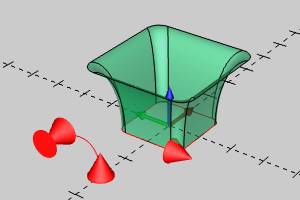
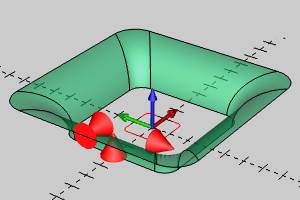
Note: The previous two options provide the same result when the start of the profile and the path are the same distance (XY) from the origin.
- OK - finalizes the function.
- Cancel - exits the function.
Quick Steps - Swung Surface
-
Open the function and define the Data Entry parameters.
-
Use the Picking Manager to chain select the path on the XY plane of the Active UCS.
-
Chain select the profile on the XZ plane of the Active UCS.
The CAD preview is automatically created when you finish chain selecting the profile. -
You can update the Data Entry parameters to see the changes in the CAD preview, if the Preview check box is selected.
-
Click OK to create the surface.
The feature is added to the CAD Tree. -
To close the function, click Cancel.
Example
A BobCAD file was installed with the software and can be opened to follow along with this example.
Part 1) Open the Example File
-
In the Quick Access Toolbar, click
 Open.
Open. -
In the Open dialog box, navigate to C:\BobCAD-CAM Data\BobCAD-CAM V**\Examples.
- With Swung Surface Example.bbcd displaying in the File Name box, click Open.
Part 2) Open Swung Surface
- In the Advanced Surfaces group, of the Create 3D tab, click
 Swung Surface.
Swung Surface.
The parameters display in the Data Entry Manager and the Picking Manager appears.
Part 3) Select the Swung Surface Chains
The first step is to select the geometry and create the CAD preview.This way we can modify the Data Entry parameters and get visual feedback of the result before creating it.
Chain Selection
Swung Surface requires two chain selections: the Trajectory Curve or path (on the XY plane) and the Profile Curve (on the XZ plane). You can perform chain selection with whichever Picking Manger option is better suited for the situation.
-
In the Parameters group, of the Data Entry Manager, select the Follow Profile Curve option.
- Use any of the Auto-Chaining option in the Picking Manager to chain select the Trajectory Curve on the XY plane. Click near either end of the chain.
Notice that the Trajectory Curve is selected on the XY plane of the Active UCS, and that the focus has shifted to the Profile Curve list.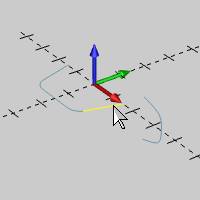
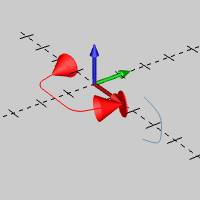
The start and end arrows display to show that the current chain selection is finished. -
Click to chain select the Profile Curve on the XZ plane. (Click near the upper end of the chain.)
Note that the Profile Curve is selected on the XZ plane of the Active UCS.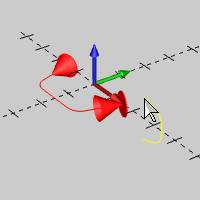
After selecting the profile curve, the CAD preview displays in the Workspace.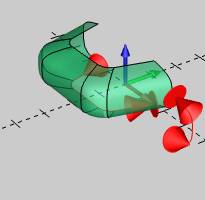
Notice the resulting surface. The profile curve follows the trajectory curve while being revolved around the Z-axis of the Active UCS. (Also, the direction of the profile curve does affect the result when using Follow Trajectory Curve as it defines where the profile starts and ends in relation to the path.)
You also have a choice to create the surface using the location of the selected profile curve.
Part 4) Modify the Data Entry Parameters
-
In the Parameters group, of the Data Entry Manager, click Follow Trajectory Curve.
The CAD preview updates to reflect the change.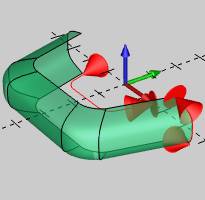
The surface now uses the location of the profile curve to define the trajectory path. -
To create the surface as shown in the CAD preview, click OK.
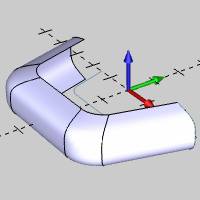
-
The Swung Surface is complete. To close the Data Entry Manager, click Cancel.
The CAD Tree
After creating a Swung Surface, it is added to the CAD Tree. This allows you to modify the results after creating the surface.
Part 5) Modifying Geometry
In this part of the example, we move our profile curve to show a few important processes.
-
In the CAD Tree Manager notice the Swung Surface feature in the CAD Tree.
You can click the feature name to highlight the surface in the graphics area.
A shortcut menu is provided to allow you to modify the feature. -
Right-click
 Swung Surface, and click Suppress/Unsuppressin the shortcut menu.
Swung Surface, and click Suppress/Unsuppressin the shortcut menu.
We are temporarily suppressing the feature to make it easier to modify the wireframe input. -
In the Move group, of the Utilities ribbon, click
 Translate.
Translate. -
In the Data Entry Manager below End, set the Z value to 2.000.
-
Click to select the profile curve.
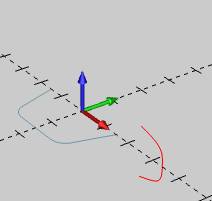
-
To confirm the selection, press Spacebar.
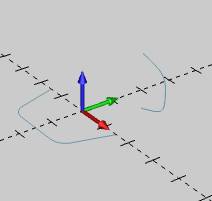
-
To close the function, click Cancel.
Part 6) Rebuild and Edit the Swung Surface Feature
-
In the
 CAD Tree, right-click
CAD Tree, right-click  Swung Surface, and click Suppress/Unsuppress.
Swung Surface, and click Suppress/Unsuppress.
The surface returns to the Workspace. -
Right-click Swung Surface, and click Rebuild.
We are rebuilding the feature because we modified the input geometry.
Notice that because we used Follow Profile Curve, the surface updates to the modified profile geometry.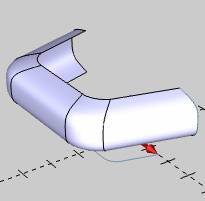
Notice that Follow Profile Curve uses the Z-axis location of the profile curve to create the surface. -
Right-click Swung Surface, and click Edit.
This option allows you to update the Data Entry parameters for the function without the need to reassign geometry.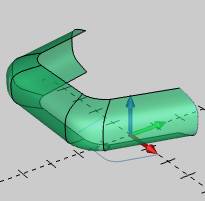
The function opens with the CAD preview displayed as the geometry is automatically pre-selected. -
In the Data Entry Manager, click Follow Profile Curve.
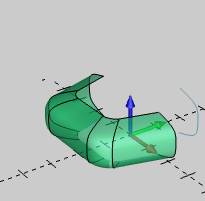
-
To update the changes to the surface, click OK.
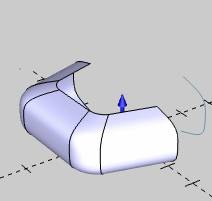
The profile curve now follows the location of the trajectory curve.
Active UCS and Revolution Axis
As a final note for Swung Surface, the location of the Z-axis of the Active UCS is an important part of the resulting surface as it is the revolution axis for the surface along the path.
The following images show the result of the same wireframe geometry used in the previous example, but created from a different UCS. Note that the following example shows more of a creative use of Swung Surface assist results in scaling or stretching of the surface in the XY plane.
Example Geometry and UCS
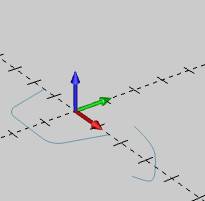
New UCS
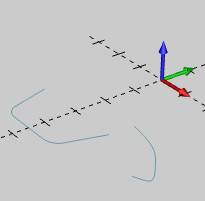
Result
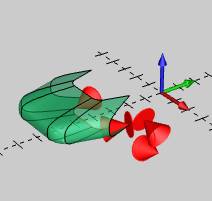
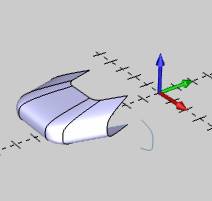
This concludes the example.






